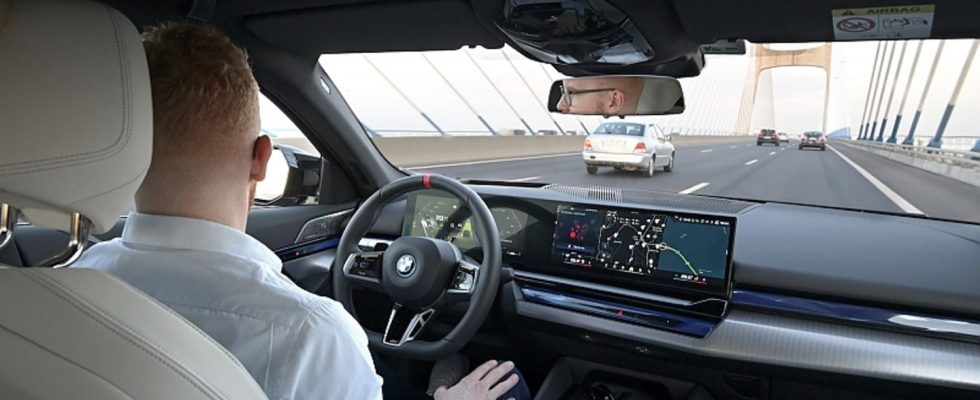Technology: BMW i5 with Autobahn Assistant in a self-test
Hands in your lap
Highway assistant in the BMW i5
© press-inform – the press office
There are major problems with highly automated driving. Just a few years ago, the step towards an automotive future without hands on the wheel didn’t seem far. But the big leap forward is taking longer than many expected. The highway assistant in the new BMW 5 Series / i5 is intended to bridge the waiting time.
Apart from the sluggish parking assistants, the range of vehicles with autonomous driving functions is very manageable. Mercedes now offers its S-Class and its electric counterpart, the EQS, with a Level 3 system in which the driver does not have to pay attention to the road for the first time. Problem: the system currently only works in Germany, only up to 60 km/h in convoy traffic and only on motorways and expressways. The other models like Audi A8 or BMW iX was once announced for driver assistance level three, but currently does not offer the system in which the car manufacturer assumes liability for any accidents. It’s surprising that the still young BMW 7 Series and the high-tech Mercedes E-Class sedan are currently failing with the Level 3 system.
The same applies to the new BMW 5 Series, which will be available from autumn as a combustion engine and electric version i5. Here, too, some had expected level three semi-autonomous driving and are now also looking into the tube, while the business sedan from Munich offers so much high-tech that one wonders why this system in particular is missing. After all, BMW is offering a consolation in its new luxury model with the highway assistant that is supposed to work. We conducted our own tests to see whether the new driving function can really relieve the driver’s everyday burden. The system is currently only approved in Germany and the USA. However, we were driving a prototype on Portuguese highways.
From the outside, the car looks like a completely normal 5 Series sedan of the latest design. Only the large stickers on the vehicle and the BMW engineer’s note that it is a special prototype with an exemption indicate the extended driving functions. It goes south from the Portuguese metropolis over the gigantic Tejo Bridge. The approval from the engineer in the passenger seat comes faster than expected and when the speed limit shows 80, 100 and then 120 km/h, the placet follows. Press the button on the steering wheel and off you go in the electric BMW i5. The green indicators in the instrument cluster only show what you could feel in the steering wheel if you had your hands on the wheel. The system is switched on and working, because the prototype stays on track easily and safely – for kilometers. But the two hands have long since wandered into their own lap, initially folded and twiddling their thumbs over the next few kilometers while the BMW safely moves along and the surrounding vehicles hardly have any idea that the near future is rolling here.
Vehicles ahead and so the instruments in the head-up display offer an overtaking function because the white Renault Kangoo is traveling at less than 100 km/h. A look to the left in the mirror, then over your shoulder out the side window and the BMW automatically switches on its indicator, pulls past and, after a quick check, pulls back into the old lane. The next time it works perfectly too – the third time it gets stuck. The reason is said to be the vehicle driving too close in the middle lane. Okay – that seems to be true, because with the necessary distance the dark Bavarian moves back to the right. By the way, all of this happens with dark sunglasses in front of your eyes – you can definitely be impressed.
When a tone signals an incoming short message on the smartphone, the driver reaches for the charging cradle in the center console. A quick look at the message and the louder tone from the angry BMW follow. The sensors in the instrument cluster noticed that the eyes were removed from the road for a few seconds. If you do it longer, the system will be forced to shut down. This is exactly what makes the difference between driver assistance levels 2+ and 3. With the 2+ system like in the new BMW 5 Series, the driver alone is responsible for being in control of the traffic situation. With the Level 3 system, the car manufacturer steps into the breach not only factually but also legally. The partially automated journey with active lane change assistant is made possible by high-tech networking. The sedan is equipped with a new software stack along with a powerful computing platform and a 5G connection to the BMW Cloud. The rest is done by cameras, ultrasonic and radar sensors of the latest generation. A real-time navigation map with exact routes, along with GPS positioning, ensures precise positioning and environmental monitoring.
After the test drive, you can only be impressed with how the Level 2+ system works in the new BMW 5 Series, because it works really well up to a speed of 130 km/h, even in strong sunlight, lively city center traffic and a driver with dark sunglasses . But the time gained in this way cannot be used to read manuscripts or check emails. You can put your hands in your lap and make the turn signal lever unusable. But that might not be enough for most users – especially because the driving function will cost a corresponding surcharge. So all you have to do is wait for the once so eloquently proclaimed Level 3 systems, where you can actually work behind the wheel – or just relax. Without always having to keep your eyes on the road.

